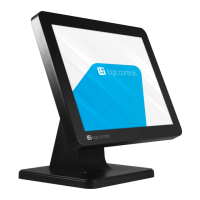
Do you have a question about the Bematech LE1015 and is the answer not in the manual?
| Aspect ratio | 4:3 |
|---|---|
| Screen shape | Flat |
| Response time | 12 ms |
| Display diagonal | 15 \ |
| Touch technology | Multi-touch |
| Display brightness | 250 cd/m² |
| Display resolution | 1024 x 768 pixels |
| Display technology | LCD |
| Touchscreen technology | Resistive |
| Viewing angle, vertical | 145 ° |
| Contrast ratio (typical) | 800:1 |
| Display diagonal (metric) | 38.1 cm |
| Viewing angle, horizontal | 160 ° |
| Product color | Black |
| Audio input | 1 |
| AC input voltage | 100-240 V |
| AC input frequency | 50 - 60 Hz |
| Power consumption (max) | 30 W |
| Power consumption (off) | 0.5 W |
| Power consumption (PowerSave) | 1 W |
| Operating temperature (T-T) | 5 - 40 °C |
| Operating relative humidity (H-H) | 20 - 80 % |
| Wall mountable | No |
| Panel mounting interface | 100 x 100 mm |
| Depth (without stand) | 230 mm |
|---|---|
| Width (without stand) | 364 mm |
| Height (without stand) | 326 mm |
| Weight (without stand) | 5500 g |
Essential safety guidelines for operating the monitor, including handling power cords and avoiding electrical shock.
Important precautions for monitor usage, covering environmental factors, cleaning, and physical interaction.
Details FCC and CE compliance statements, including operational conditions and conformity to European directives.
Lists all the items included in the product package, such as the monitor, cables, and user manual.
Highlights the key features and design aspects of the LE1015 True-flat LCD Touch Monitor.
Guides on connecting the monitor to a computer using VGA, USB, and power cables.
Specifies screw types and lengths for VESA mounting, ensuring secure attachment to stands or walls.
Step-by-step instructions for installing the optional magnetic stripe reader module.
Provides guidance on connecting and mounting an optional second display to the touch monitor.
Details the functions of the five control buttons on the monitor for setup and operation.
Explains the various settings available through the monitor's On-Screen Display (OSD) menu.
Instructions for installing the touch screen driver, starting with file selection and initial setup steps.
Troubleshooting steps for when the monitor displays no image, checking power saving and cable connections.
Guidance on adjusting display brightness and contrast using the OSD menu for optimal viewing.
Steps to correct display fitting issues, using auto-adjust or manual OSD settings for H position, V position, and clock.
Troubleshooting steps for unclear text, focusing on matching resolution and refresh rate with display mode.
Solutions for inaccurate touch screen response, recommending calibration and checking driver installation.
Resolving issues where the cursor movement is reversed relative to touch input, suggesting calibration.
Troubleshooting for a cursor stuck at the LCD edge, checking for physical obstructions and screen cleanliness.
Addressing limited touch input areas or inaccurate touch positions, recommending calibration after driver installation or resolution changes.
Troubleshooting steps for when the touch screen does not respond to operations, checking driver and calibration.
Details specifications for the LCD touch panel, including size, brightness, response time, and resolution.
Provides mechanical details of the monitor, such as net weight and dimensions.
Outlines the electrical requirements, including power supply input and consumption.
Specifies the environmental operating conditions, like temperature and humidity ranges.
Covers miscellaneous features and compatibility, including Plug & Play, VESA compatibility, and optional modules.